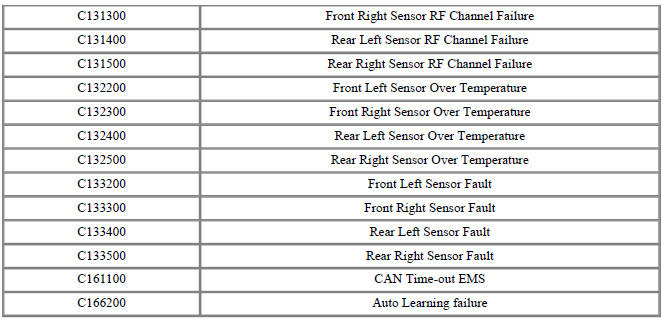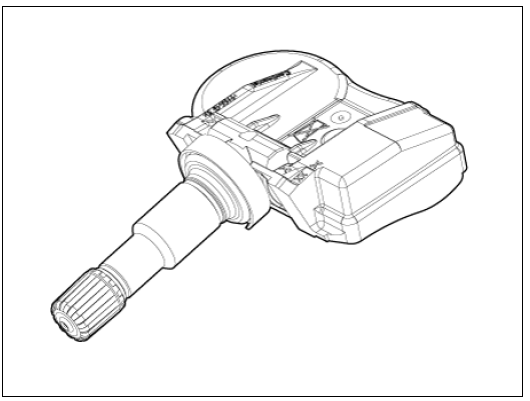KIA Niro: Troubleshooting - Tire Pressure Monitoring System
TPMS Inspection method

Inspection
Warning
Find the inspection number by referring to the table above.
The following content is irrelevant of the inspection procedure.
- Warning lamp types
- Stays on without blinking : Low pressure tire warning lamp
- Flashes at 0.5 second intervals constantly : Initial state warning lamp
- Cluster blinks for 1 minute at 1 second intervals, then turns ON : Error code warning lamp
Warning
Turn IG OFF and then IG ON again to check the warning light type.
- (1) Check the warning lamp state.
- Check the vehicle warning lamp state.
- Check if the warning lamp state is caused by tire low pressure.
 Symptom : Stays on without
blinking
Symptom : Stays on without
blinking
- (2) Check the warning lamp state.
- Check the vehicle warning lamp state.
- Check if the warning lamp state is caused by the initial state (virgin mode) of TPMS receiver.
 Symptom : Flashes at 0.5 second
intervals constantly.
Symptom : Flashes at 0.5 second
intervals constantly.
- (3) Check the warning lamp state.
- Check the vehicle warning lamp state.
- Check if the warning lamp state is caused by error code (TPMS receiver & TPMS sensor failure).
Symptom : Cluster blinks for 1 minute at 1 second intervals, then turns ON.
- Low tire pressure warning lamp
Cold : Vehicle that has been stationary for over 60 minutes
→ 0.07 kgf/cm² (1.0 psi) additional injection at the specified tire pressure.
Hot : Driven vehicle
→ 0.28 kgf/cm² (4.0 psi) additional injection at the specified tire pressure.
Warning
In case the warning lamp fails to turn OFF after injecting tire pressure, disconnect the KDS/GDS and drive less than 1 km at 25 km/h.
- Inspect initial state warning lamp
A. TPMS warning lamp
(1) Check the TPMS warning lamp status.
(2)Flashes at 0.5 second intervals constantly. -> Initial state warning lamp
Warning
Turn IG OFF and then IG ON again to check the warning lamp type.
- Items to check in case of blinking warning lamp
(1) Enter sensor ID.
(Refer to TPMS Receiver - "Repair procedures") (2) Enter vehicle name.
(Refer to TPMS Receiver - "Repair procedures") (3) Enter VIN.
(Refer to TPMS Receiver - "Repair procedures") (4) Change TPMS ECU mode (to Standard mode).
- DTC checklist for performance test.


Warning
- Be sure to check DTC.
(Refer to DTC manual - "Tire Pressure Monitoring")
- If the TPMS warning light does not turn on : TPMS sensor periodically learns the sensor through driving.
- If the TPMS warning light turns on : Replace TPMS sensor and TPMS receiver.
TPMS Sensor Description and operation
Description

- Function
- By detecting the pressure, temperature, acceleration, and battery condition, transmit information to ECU by a wireless RF.
- Wheel location is recognized by comparing the Wheel Pulse of ECS (ABS) and acceleration values of the sensor (High Line).
- Structure and features
- There are four (4) sensors each mounted on each wheel of the vehicle.
- Frequency conversion type is FSK, and High Line is used in common.
TPMS Automatic Location Learning
- The wheel angular velocity of each wheel is different from each other in the following cases:
1) Different slip occurs for each axis.
2) Rotation radius (the radius of curve) is different by wheel.
3) Tire wear, internal pressure, tire specifications, etc. are different by tire.
- TPMS sensor is transmitted to RF signal at only specific phase (the angle of the tire) in the learning mode.
- TPMS receiver checks each tire phase (tire angle) information on receiving RF signals from the sensor.
- Every time RF signals from sensor IDs 1, 2, 3, and 4 are received, the ID with the highest correlation among the phase of each collected wheel is transmitted. (In other words, each time RF signal is received, the phase of the tire is transmitted to the most constant wheel.)
- TPMS sensor transmits the RF signal at intervals of 16 seconds in the learning mode.
- After stopping or parking for more than 19 minutes, automatic learning function in every driving position is performed.
- The sensor is converted to Parking Mode when stopped or parked for more than 15 minutes. When acceleration of over 4g (15-20km/h) is detected in Parking Mode, it is converted to First Block Mode.
READ NEXT:
 TPMS Sensor Repair procedures
TPMS Sensor Repair procedures
Removal
Remove the valve core and deflate the tire.
Remove the side of the tire bead area from the wheel using tire changing
machine .
Warning
The tire bead should be broken approx. 90º from the valve side
of the wheel. The be
 TPMS Receiver Repair procedures
TPMS Receiver Repair procedures
Removal
Disconnect the battery negative cable.
Remove the glove box.
(Refer to Body - "Glove Box Housing")
Disconnect the blower motor connector (A).
Disconnect the body control module (BCM) connector (A).
Loos
SEE MORE:
 Fastening and releasing the seat
belt
Fastening and releasing the seat
belt
3-point system with emergency locking retractor
Operation
To fasten the seat belt, insert the
metal tab into the buckle (2).
To release the seat belt, press the
release button (1) in the locking
buckle.
INFORMATION
There will be
 Information on data processing
Information on data processing
Any processing of personal data through
the 999-based eCall in-vehicle system
shall comply with the personal data protection
rules provided for in Directives
95/46/EC (1) and 2002/58/EC (2) of the
European Parliament and of the Council,
and in
Categories
- Home
- KIA Niro EV, Hybrid - Second generation - (SG2) (2021-2024) - Owner's manual
- Kia Niro - First generation - (DE) (2017-2022) - Service and Repair Manual
- Contact Us
